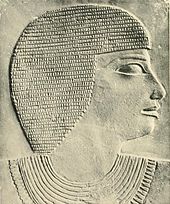Akhethetep (son of Ptahhotep)
Appearance

| |||||
| Akhethétep in hieroglyphs | |||||
|---|---|---|---|---|---|
| Era: Old Kingdom (2686–2181 BC) | |||||
Akhethetep (also Akhethotep or Akhty-hotep) was a high dignitary of Ancient Egypt who lived during the Fifth Dynasty around 2400 BC.[1] Akhethotep and his son Ptahhotep Tshefi were senior court officials during the rule of Djedkare (2414-2375 BC) and of Unas (Weinis), towards the end of the 5th dynasty (2494 to 2345 BC).[2][3][4]
He is famous for his tomb, discovered in Giza by French Egyptologist Georges Aaron Bénédite in 1903 and which was later reassembled in the Louvre. One of the depictions on the wall of the tomb was Akhethotep directing the building of the tomb. On one stele Akhethotep is called "prophet of the Unas pyramid Nefer asut"; but on the other he is "prophet of the Unas pyramid Asut asutt."[5]
References
- ^ "Sacrificial chamber of the tomb of Akhethotep". Heritage Key. Archived from the original on 14 March 2011. Retrieved 8 April 2011.
{{cite web}}: Unknown parameter|deadurl=ignored (|url-status=suggested) (help) - ^ "Egyptian Monuments". Tomb of Akhethotep and Ptahhotep. Egyptsites.wordpress. Retrieved 9 April 2011.
- ^ "Lonely Planet review for Tomb of Akhethotep & Ptahhotep". Lonelyplanet. Retrieved 9 April 2011.
- ^ Jozef M. A. Janssen; International Association of Egyptologists. ANNUAL EGYPTOLOGICAL BIBLIOGRAPHY 1975. Brill Archive. pp. 109–. GGKEY:7HUN9CNK03G. Retrieved 9 April 2011.
- ^ Petrie, Sir William Matthew Flinders; Mahaffy, Sir John Pentland; Milne, Joseph Grafton; Stanley Lane-Poole (1903). A history of Egypt. Methuen & co. Retrieved 16 April 2011.
